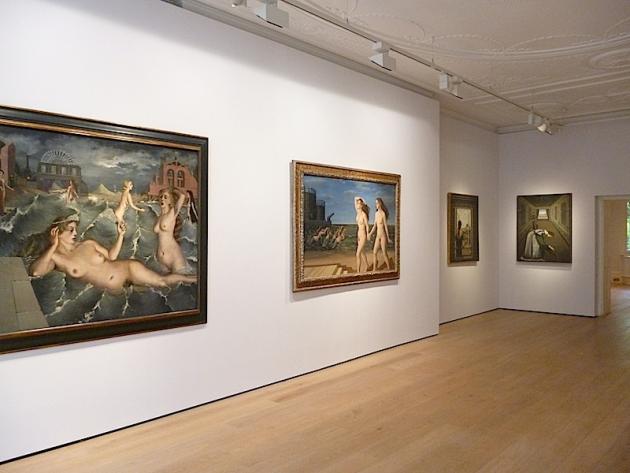“I would like to create a fabulous painting I which I would live, in which I could live” – Paul Delvaux (1897-1994)
There is a theatrical quality to work of Paul Delvaux where he choreographs narratives of melancholia and eroticism with scenes mostly inhabited by naked women. These strange, but appealing, surreal worlds are occupied by silent protagonists whose deadpan gazes appear to speak volumes in spite of their taciturnity. They seem to be at odds with their surroundings, disconnected from nature and incongruously plopped onto proscenia as if they have just stepped out of a time machine.
Architectural sets predominate many of the tableaux with neoclassical references that reoccur with increasing regularity throughout the work. In “Jeune femme devant une temple” (1949), the protagonist dominates the foreground in a left to right upward diagonal sweep of the composition. Articulated lines of the ground tiles recede towards a vanishing point with a classical temple in the background. A toga-clad male “antagonist” inhabits the middle ground, whilst a half-naked female “chorus member” weeps over a sarcophagus. Reason and order lie side by side, doing battle with the unspoken torment of melancholia. A similar dissonance transpires with pictorial elements such as the systematic codes of symmetry alongside the highly decorative, which also occur in repeated motifs such as jewel-encrusted tiaras, embroidered collars, fans, hatpins or lace details.
In “L’eloge de la melancholie” (1948), a similar scene is placed in a different time warp, only this time it moves to an interior setting. The naked foreground figure, whose only bodily embellishment is her highly bejeweled neck, lies in pensive contemplation, taking in the view of a woman whose exquisite lace clothing, echoing the intricacy of the necklace, falls languidly off her body. Repetition of this curlicue pattern pops up in the wrought iron of the double doors, her hair, and a set of hatpins, that immobilizes a garment to the floor like tress on a miniature landscape. The animated face of a Greek male statue, whose sideways glance gives us a hint of what might just have taken place, witnesses the scene.
Delvaux’s palette is muted yet rich with colours that allude to mood, atmosphere sensuality and the workings of the unconscious. Influences from Magritte and De Chirico are apparent yet understated because he has made the space of his creations very much his own.
Other features in his paintings include tilted picture planes, elements of the absurd, and incongruous connections between people and place, all of which add to a sense of the theatrical as a form of catharsis. In “Le Sabbat” (1962), a trio of partially clothed women, bearing floor-length headdresses made of leaves, engages in some form of silent communication. Their gaze is deadpan but they seem to gesticulate animatedly in the foreground. As we move back into the picture plane, the female characters occupy various positions moving deeper into space and in various stages of undress. The central figure in the mid-ground faces us directly in the very centre of the image with legs spread apart in a triangle shape, directing our eye as a passage through them as she pulls her dress over her head. Just behind her two naked women wrestle one another, whilst a fully clothed, bespectacled male character pleads with his reflection in a full-length mirror.
I particularly liked the room in the centre of the gallery, dedicated to a series of works on paper in India ink and watercolour. They had a tactile quality whose surface richness was owing to the heavily worked drawn elements with crosshatching, tiny detail, and transparency of the colours, imbuing them with a delicate virtuosity and sensitivity of touch, as well as a nineteenth century aesthetic that appealed to a sense of visual nostalgia, and recall Delvaux’s early obsession with Jules Verne.
WORDS AND PHOTOS: KAREN GARRATT
The exhibition is at Blain Di Donna’s elegant Mayfair location until July 17th.

